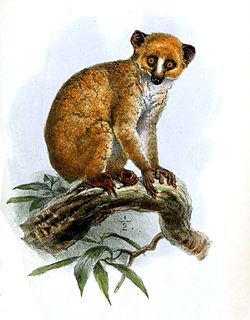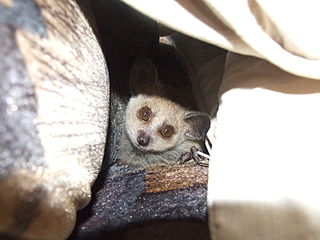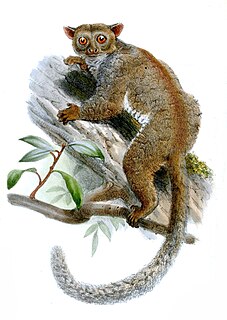 W
WGalagos, also known as bush babies, or nagapies, are small nocturnal primates native to continental, sub-Sahara Africa, and make up the family Galagidae. They are considered a sister group of the Lorisidae.
 W
WLorisoidea is a superfamily of nocturnal primates found throughout Africa and Asia. Members include the galagos and the lorisids. As strepsirrhines, lorisoids are related to the lemurs of Madagascar and are sometimes included in the infraorder Lemuriformes, although they are also sometimes placed in their own infraorder, Lorisiformes Gregory, 1915.
 W
WGalagos, also known as bush babies, or nagapies, are small nocturnal primates native to continental, sub-Sahara Africa, and make up the family Galagidae. They are considered a sister group of the Lorisidae.
 W
WLoris is the common name for the strepsirrhine primates of the subfamily Lorinae in the family Lorisidae. Loris is one genus in this subfamily and includes the slender lorises, while Nycticebus is the genus containing the slow lorises.
 W
WAngwantibos are two species of strepsirrhine primates classified in the genus Arctocebus of the family Lorisidae. They are also known as golden pottos because of their yellow or golden coloration.
 W
WAngwantibos are two species of strepsirrhine primates classified in the genus Arctocebus of the family Lorisidae. They are also known as golden pottos because of their yellow or golden coloration.
 W
WThe Central African potto is a species of nocturnal strepsirrhine primate. It is found in Central Africa. It is also known as Milne-Edwards's potto, after Alphonse Milne-Edwards.
 W
WSlow lorises are nocturnal strepsirrhine primates in the genus Nycticebus that live in the rainforests of South and Southeast Asia. They are threatened by habitat loss and fragmentation from deforestation, selective logging, and slash-and-burn agriculture, as well as by collection and hunting for the wildlife trade, including the exotic pet trade, and for use in traditional medicine and as bushmeat. Because of these and other threats, all five species of slow loris are listed as either "Vulnerable" or "Endangered" by the International Union for Conservation of Nature (IUCN). Their conservation status was originally listed as "Least Concern" in 2000 because of imprecise population surveys and the frequency in which these primates were found in animal markets. Because of their rapidly declining populations and local extinctions, their status was updated and in 2007 the Convention on International Trade in Endangered Species of Wild Fauna and Flora (CITES) elevated them to Appendix I, which prohibits international commercial trade. Local laws also protect slow lorises from hunting and trade, but enforcement is lacking in most areas.
 W
WThe eastern dwarf galagos are a group of seven species of strepsirrhine primates of the family Galagidae, native to East Africa. They were formerly classified in the genus Galagoides but have been moved to their own genus, Paragalago, based on genetic evidence, and supported by differences in vocalizations and morphology. The three western/Congolian species remain in Galagoides.
 W
WThe needle-clawed bushbabies are the two species in the genus Euoticus, which is in the family Galagidae. Galagidae is sometimes included as a subfamily within the Lorisidae.Genus Euoticus Southern needle-clawed bushbaby, E. elegantulus Northern needle-clawed bushbaby, E. pallidus E. p. pallidus E. p. talboti
 W
WLesser bushbabies, or lesser galagos, are strepsirrhine primates of the genus Galago. They are classified, along with the bushbabies and the rest of the galagos, in the family Galagidae. They are probably the most numerous primate in Africa, and can be found in every large forest on the continent, inhabiting forested areas, savannas, riverine bush and open woodlands.
 W
WThe western dwarf galagos are a group of three species of strepsirrhine primates, native to western and central Africa. They are classified in the genus Galagoides of the family Galagidae. The eastern dwarf galagos have been moved to their own genus, Paragalago, based on genetic evidence and differences in vocalization. The two genera are not sister taxa and thus may have evolved their small sizes via parallel evolution. They are separated by the East African Rift.
 W
WLesser bushbabies, or lesser galagos, are strepsirrhine primates of the genus Galago. They are classified, along with the bushbabies and the rest of the galagos, in the family Galagidae. They are probably the most numerous primate in Africa, and can be found in every large forest on the continent, inhabiting forested areas, savannas, riverine bush and open woodlands.
 W
WLoris is the common name for the strepsirrhine primates of the subfamily Lorinae in the family Lorisidae. Loris is one genus in this subfamily and includes the slender lorises, while Nycticebus is the genus containing the slow lorises.
 W
WThe slender lorises (Loris) are a genus of loris native to India and Sri Lanka. The genus comprises two species, the red slender loris found in Sri Lanka and the gray slender loris from Sri Lanka and India. Slender lorises spend most of their life in trees, traveling along the tops of branches with slow and precise movements. They are found in tropical rainforests, scrub forests, semi-deciduous forests, and swamps. The primates have lifespans of approximately 15 years and are nocturnal. Slender lorises generally feed on insects, reptiles, plant shoots, and fruit.
 W
WLorisidae is a family of strepsirrhine primates. The lorisids are all slim arboreal animals and comprise the lorises, pottos and angwantibos. Lorisids live in tropical, central Africa as well as in south and southeast Asia.
 W
WThe needle-clawed bushbabies are the two species in the genus Euoticus, which is in the family Galagidae. Galagidae is sometimes included as a subfamily within the Lorisidae.Genus Euoticus Southern needle-clawed bushbaby, E. elegantulus Northern needle-clawed bushbaby, E. pallidus E. p. pallidus E. p. talboti
 W
WThe Bengal slow loris or northern slow loris is a strepsirrhine primate and a species of slow loris native to the Indian subcontinent and Indochina. Its geographic range is larger than that of any other slow loris species. Considered a subspecies of the Sunda slow loris (N. coucang) until 2001, phylogenetic analysis suggests that the Bengal slow loris is most closely related to the Sunda slow loris. However, some individuals in both species have mitochondrial DNA sequences that resemble those of the other species, due to introgressive hybridization. It is the largest species of slow loris, measuring 26 to 38 cm from head to tail and weighing between 1 and 2.1 kg. Like other slow lorises, it has a wet nose (rhinarium), a round head, flat face, large eyes, small ears, a vestigial tail, and dense, woolly fur. The toxin it secretes from its brachial gland differs chemically from that of other slow loris species and may be used to communicate information about sex, age, health, and social status.
 W
WThe greater galagos or thick-tailed bushbabies are everyday names for three species of strepsirrhine primates. They are classified in the genus Otolemur in the family Galagidae.
 W
WPerodicticinae is a subfamily of the family Lorisidae. It includes five species of African primates as shown under taxonomy below.
 W
WThe pottos are three species of strepsirrhine primate in the genus Perodicticus of the family Lorisidae. In some English-speaking parts of Africa, they are called "softly-softlys".
 W
WThe pottos are three species of strepsirrhine primate in the genus Perodicticus of the family Lorisidae. In some English-speaking parts of Africa, they are called "softly-softlys".
 W
WThe slender lorises (Loris) are a genus of loris native to India and Sri Lanka. The genus comprises two species, the red slender loris found in Sri Lanka and the gray slender loris from Sri Lanka and India. Slender lorises spend most of their life in trees, traveling along the tops of branches with slow and precise movements. They are found in tropical rainforests, scrub forests, semi-deciduous forests, and swamps. The primates have lifespans of approximately 15 years and are nocturnal. Slender lorises generally feed on insects, reptiles, plant shoots, and fruit.
 W
WThe squirrel galagos are a group of four species of strepsirrhine primates. They are classified in the genus Sciurocheirus of the family Galagidae.Genus Sciurocheirus Bioko Allen's bushbaby, S. alleni Cross River bushbaby, S. cameronensis Gabon bushbaby, S. gabonensis Makandé squirrel galago, S. makandensis
 W
WThe West African potto is a species of nocturnal strepsirrhine primate. It is found in tropical West Africa. It is also known as Bosman's potto, after Willem Bosman, who described the species in 1704. It is the type species of the genus Perodictitus.
 W
WThe western dwarf galagos are a group of three species of strepsirrhine primates, native to western and central Africa. They are classified in the genus Galagoides of the family Galagidae. The eastern dwarf galagos have been moved to their own genus, Paragalago, based on genetic evidence and differences in vocalization. The two genera are not sister taxa and thus may have evolved their small sizes via parallel evolution. They are separated by the East African Rift.